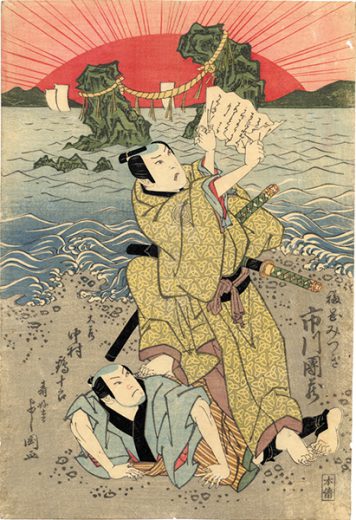Spiritual sites in ukiyo-e
March 6 (Tue), 2018 – June 3 (Sun), 2018
This museum exhibits ukiyo-e paintings produced in Osaka in the Edo period. Most of the ukiyo-e paintings made in Osaka were portraits of kabuki actors. They depict kabuki actors playing in kabuki theatres.
In kabuki plays, the descriptions of the four seasons make the story colourful. You can feel that you are there by seeing the landscape paintings. You can also feel that you are visiting the actual places, shrines and temples by enjoying the kabuki plays performed with the background scenery of these constructions.
In this feature exhibition, we focus on temples and shrines appeared in kabuki plays. People at the time needed to get permission from the authorities to travel and their travel purpose was often to visit temples/shrines. Kabuki plays with the scenes of shrines and temples might have satisfied the people’s desire for travel. Wish you a good luck by looking at ukiyo-e paintings.

“Ise Ondo Koi no Negatana”, drawn by Jukodo Yoshikuni
Shrines and temples in kabuki plays – seeking for good luck
People in the Edo period visited shrines, what is now called ‘spiritual sites’, to get good luck. When someone was ill, the family members made the pilgrimage to a shrine to pray to the gods and make an oath not to have a certain things until the recovery. In the kabuki play “Sugawara no denju tenarai kagami”, the story begins when the daughter of Kan Josho and the brother of the Emperor secretly meet during the ritual for the Emperor to recover from illness.
Kabuki plays were sometimes played in shrine’s compounds. It was called Miyachi or Miyashibai (shirine’s grounds or shrine’s play), played in the provisional theatres with the permission by the shrine. In Osaka such theatres were in the Goryosha and Temmangu, and it is said to have made a great success (See the scene in the uikiyo-e paintings here). The success might have been a blessing of the shrine.
People who became god
Other than gods in the mythology and all variety of spirits that inhabit the mountains and trees, there are actual people who became gods.
Sugawara no Michizane (Kan Josho in “Sugawara Denju Tenarai Kagami” ) died in resentment and became an evil spirit. People worshiped him in order to calm his spirit.
Tokugawa Ieyasu, the founder of the Edo shogunate, was enshrined at the Nikko Toshogu after his death, while Toyotomi Hideyoshi was enshrined at the Toyokuni shrines.
Yorimasa shrine was built at the site where he commited suicide after being defeated by the Heishi clan. Takeisao shrine enshrines Oda Nobunaga by order of the Meiji Emperor. These are shrines that enshrine actual person who made a great achievement. People made their legendary stories into kabuki plays. It is possible that the enshrined person gives the spiritual power to the actor on stage.
Seeing temples and shrines in plays – longing for pleasure trip
In the Edo period, highways such as Tokaido were built, and most people travelled on foot. During the times that ukiyo-e were produced in Osaka, great many people made pilgrimage to the Ise Grand Shrine like two famous travelers, Yaji-san and Kita-san in “Tokaidochu Hizakurege”
Famous shrines and well-known products of temples that were depicted in kabuki plays must have enhanced the audience’s mood for sight-seeing. The famous words of Ishikawa Goemon standing at the Sanmon Gate saying “What an amazing view” reminds us of the beautiful view in Kyoto. Tsutenkyo bridge in Kaneiji temple reminds us of the view of beautiful autumn leaves.
Kabuki plays that were based on the actual events such as “Katakiuchi Sozenjibaba” might have played the role of contemporary tabloid talk show TV. Graves of brothers are still placed at Sozenji temple where the tragedy occured that the brothers who sought revenge got killed on the contrary. After enjoying ukiyo-e paintings, please enjoy a journey to places that famous kabuki plays are set.
Famous places in Osaka
“Keihan Miyage Meisho Zuga 20yo” is a collection of ukiyo-e woodblock prints of the each ten famous places in Kyoto and Osaka, and was made in 1895 (Meiji 28). In addition to the prints of Yasaka shrine and Kinkakuji temple, a print of the site of the fourth Naikoku Kangyo Hakurankai (the fourth national expo for the promotion of industry) are also among the 10 Kyoto famous places. It seems that the collection of woodblock prints was made at the timing of the expo was held.
In addition to the prints of Temmangu and Shitennoji temple, Mint of Japan and Tenjin bridge are among the collection. Tenjin bridge is a truss bridge, imported from Germany in Meiji 21 (1888). It shows that even in Osaka in the modern era after the Meiji period, temples and shrines still exist as famous places along with new constructions.